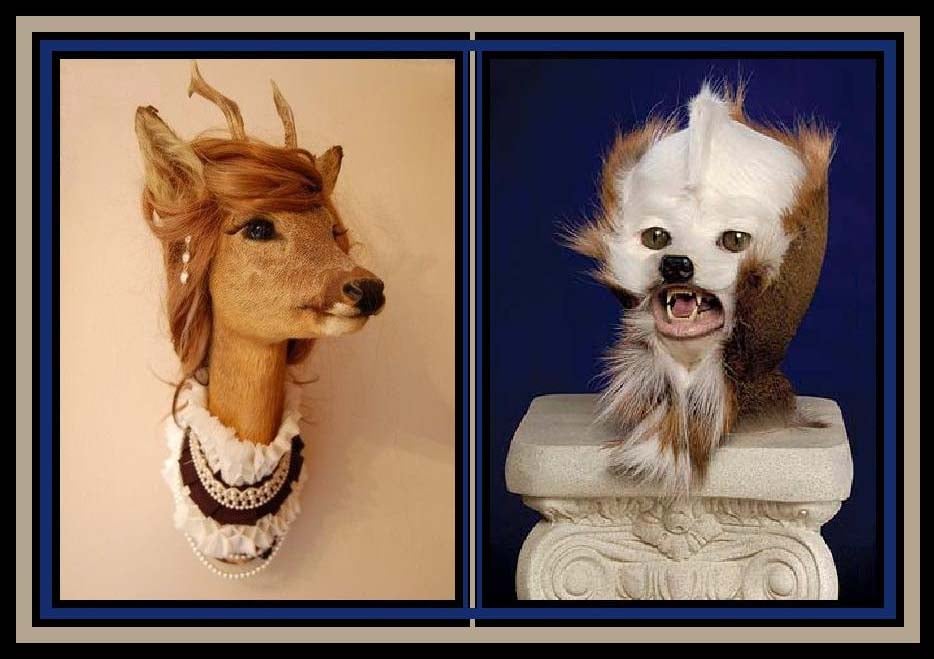
Last Updated on
By Tony Martins
It’s been more than a year since you killed the biggest buck of your life, and the taxidermist just called with news that your long awaited mount is ready for pick up. Excitement grows as you walk into the shop, anticipating the first look at your trophy – but, where is it? “This is your buck” the clerk says, pointing to a mount that you don’t recognize. In disbelief you stammer, “thaa.. that’s mine?” “Well… yes” says the clerk, handing you a bill for balance due on the work, while your stomach flip-flops like a fish on a boat deck. You’ve just become an unwitting member of a rather sizeable fraternity: Victims of Bad Taxidermy.
This happened to me years ago with the third animal I had ever mounted – guess I was just lucky on the first two! Using a muzzleloader, I had taken a beautiful young pronghorn in his prime. We had named this buck “Mighty Might” for his aggressive behavior in defending his harem of 15 does against a half dozen challengers daily. The animal the taxidermist delivered looked old and decrepit – like it had died from malnutrition – with caved-in face and bugged out eyes. The broad, almost black strip from forehead to nose was absent. In its place was a faded looking red-brown strip. When questioned, the taxidermist admitted that my cape – which was carefully removed in the field and chilled in a cooler until delivery – had been ruined in the tanning process. Thus, another cape was substituted, and apparently glued directly to an undersized form with no build-up or fill-in. Also colored differently than mine, it furthermore had a large patch sewed in on the back of the neck. Although this disaster may not have been entirely his fault, this taxidermist has understandably, not been given the chance to mount another animal for me.
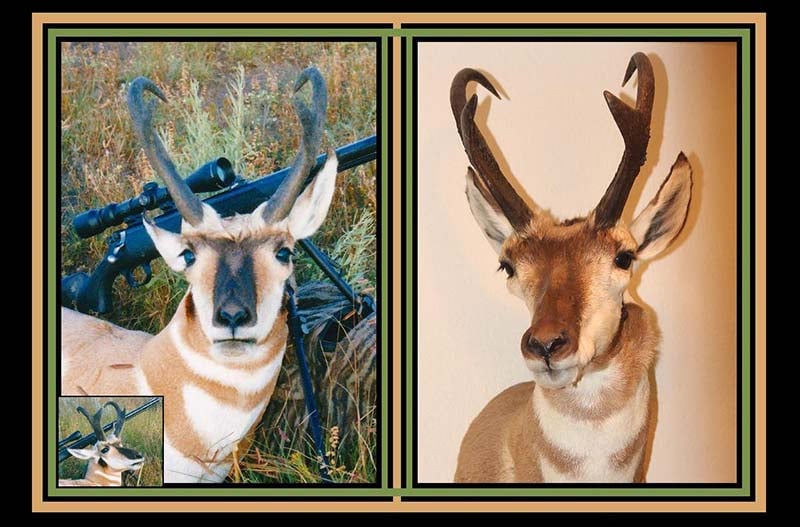
So, how can taxidermy disasters like the one above be avoided? There are lots of things that can go wrong from the time an animal is taken in the field to the time the finished trophy mount is completed. One important key to a satisfactory outcome is two-way communication between hunter and taxidermist. Often there is no communication during the six months to a year or more, while the work is in progress. Had the taxidermist who mounted my pronghorn alerted me that its cape had been ruined, I might have opted for a European skull mount rather than the shoulder mount originally ordered. Of course, I did not ask the taxidermist to alert me if a problem developed, so he didn’t. Hides sometimes return from tanneries in unsuitable condition for mounting (for a variety of reasons), so taxidermists keep extra hides of common animals on hand. Substitutions are made when necessary, usually without notification. I suspect this is done to avoid risking loss of the business. You should ask the taxidermist to contact you immediately about any problems that develop while work on your mount is in progress.
Judging taxidermy is not difficult, as bad taxidermy can be easily differentiated from good. Does the animal look alive and presented in a natural pose, or does it remind you of a failed 7th grade science project? Details like eye set and socket sculpture, hair finish, feather set, painting, seamless sewing, and fine points like skin folds and vein detail separate the work of true professional wildlife artists from the rest of the pack. As a writer, I take lots of photos in the field, and spend considerable time to insure the photos are well posed and good quality. These are an excellent resource for assessing completed taxidermy work, and I often display a framed field photo alongside the mount. If the finished taxidermy looks like the animal in the photo(s), the project has been a success!

Satisfaction is often a function of expectation, and this is particularly true with taxidermy. Good taxidermists are highly skilled and artistic, but they are not magicians! If you deliver an animal hide that is full of knife cuts (holes) and missing patches of hair, don’t expect the finished mount to be pristine. Likewise, if that bobcat has been in your freezer for so long that its nose, ears and skin are “burned” you cannot expect the taxidermist to turn it into a vivid, life-like mount – instead, it will likely look “stuffed.”
Bad taxidermy often starts in the field. Common mistakes include damaging the hide during removal and hide spoilage due to heat and/or bacterial contamination. In the west, where hunters must deal with warm temperatures during early seasons, it’s important to remove capes/hides and cool them as soon as possible. In the east, harvested animals often must be presented at inspection stations with hides intact but again, these should be removed, cooled, cleaned and fleshed as soon as possible. If your return from the field will be delayed several days after harvest, it’s a good idea to flesh the hide and apply salt to draw out remaining moisture and retard bacterial growth. Spoilage causes hair to “slip” (fall out). Most taxidermists will reject hides/capes if their condition is questionable.

Removing the hide and/or caping in the field for taxidermy is not difficult, although some aspects can be a little tricky. Extra care must be taken around eyes and lips and in turning the ears to insure a high-quality mount. Instructions for completing these tasks are beyond the scope of this article however, professional bowhunter and outfitter, Fred Eichler, has a number of excellent instructional videos posted on his YouTube channel. Here’s a good tip: Some wild game meat processing operations welcome volunteer skinners during peak times. What better way to practice your skinning skills? This is also an excellent venue to practice caping. A quality knife with replaceable razor-sharp blades, like the Outdoor Edge Razor-Lite available at Gritr Sports is an excellent choice for this work, and I never go into the field without one. I also like the Outdoor Edge Dark Timber Combo, with both skinning and caping knives.
Most taxidermists will advise on how to prepare animal skins, birds and fish for mounting. If the specimen will be frozen for a length of time prior to mounting, it needs to be protected from desiccation that will cause deterioration. For example, Paul Taylor (owner/operator of Taylor Made Taxidermy in Scottsdale, AZ – 480-990-2709) recommends the following prep prior to freezing for waterfowl to be mounted later: Saturate birds with a solution of mild dish washing soap and water, roughing the feathers to insure wetting down to the skin. Tuck heads and feet under wings for additional protection, wrap tightly in a towel dampened with the soapy solution, and then freeze. I’ve followed this advice, with outstanding results.
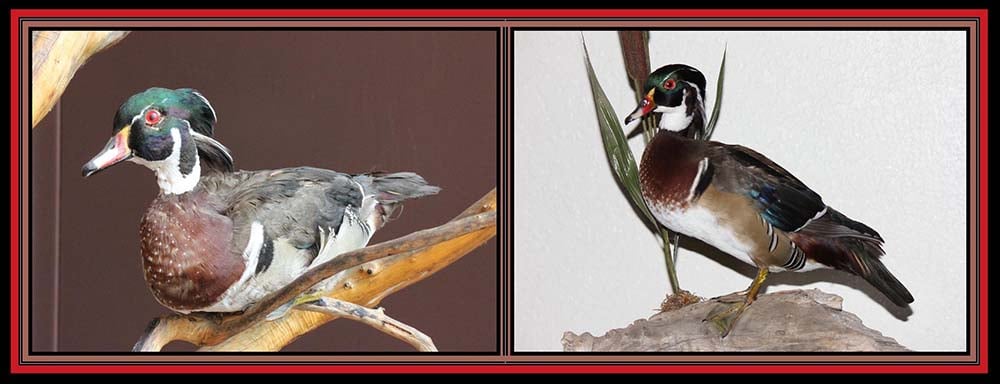
Selecting A Taxidermist
It’s surprising how much taxidermy today is still performed with a handshake agreement. In this day and age, you can’t get a $30.00 oil change without a written contract, but a $500.00 shoulder mount is often initiated with a cash deposit, and no paperwork whatsoever! Some truly outstanding taxidermy is turned out by micro-businesses of the one-man-show type. Nevertheless, when a hard-earned and often irreplaceable trophy animal is entrusted to a taxidermist, there should be a formal written agreement between both parties, so each party knows what to expect from the other. Most of the larger taxidermy companies will have a contract that is designed for the most part to limit their liability. If tanning is done off-site by a third party for example, the contract will protect the taxidermy company from liability and loss due to tanning issues. It will typically include a description of the mount type (wall, floor, pedestal, rug etc.) and positioning (head turn, upright, sneak, etc.), as well as display features (faux rock base, driftwood, wall mount shield, etc.) and extras (open mouth with insert, special eyes, etc.). It should include payment terms, deposit and balance due amounts, and anticipated completion date. If the work is going to take 2-3 years to complete, the customer should be informed of this up front.
Many small taxidermy businesses do not use written contracts, preferring to operate by-the-seat-of-their-pants. If you do business with one of these operations, you can avoid future disagreements and problems by making notes on a pad while discussing the work. Later, type up your notes and deliver a copy – in person if possible – to the individual who took your order. Ask for the copy to be placed in your file, for review by the taxidermist who will mount your animal. This is a low-pressure, win-win approach, and your effort should be appreciated by businesses that take pride in their work. If you took photos of your animal in the field – and you should – print some copies and deliver these as well. Most good taxidermy artists will welcome photos of your animal for reference during the preservation process. If they are not interested in your photos, beware! This is a red-flag that they may use set poses, materials and procedures to expedite the process, rather than taking the time necessary to create a mount that looks like the animal you delivered.
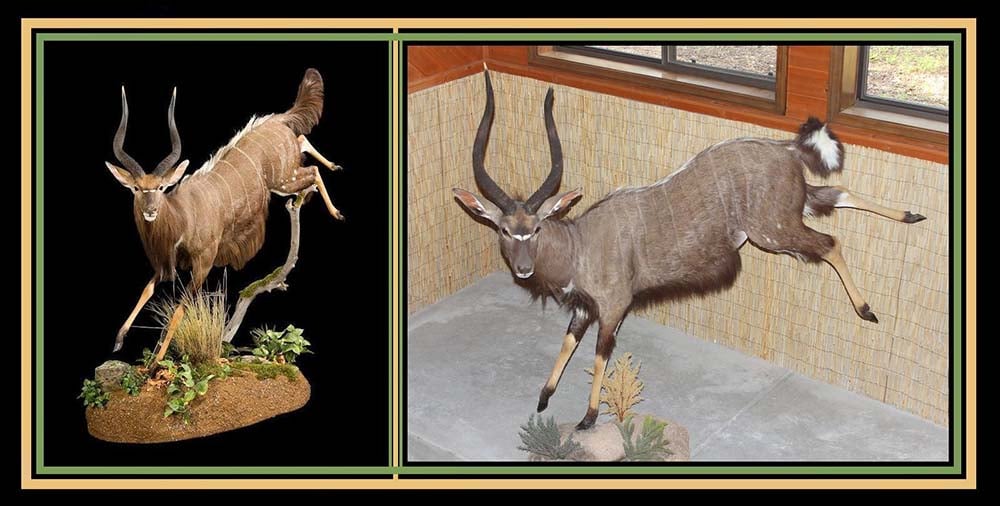
Selecting a taxidermist is often a matter of convenience or price, or both. If one taxidermist in town charges $750 for a shoulder mount with a 2-year wait and a shop full of animals, while another charges $350 for a “comparable” mount that will be completed in a few months, there are probably good reasons for these differences! Solid references, especially from hunters/fishermen you know and trust, are invaluable. Although a step lower on the scale of importance, reputation – for quality work as well as problem-free business dealings – is another consideration. Here’s an important tip: Ask who will actually do the work on your mount. Too often, customers are influenced by museum-grade mounts displayed in showrooms or on-line image galleries, particularly with the larger taxidermy companies. Your animal may, or may not, be mounted by the taxidermist whose artistry you admired. In fact, some or all of the work could be done by an apprentice, or even sent to an outside contractor. One taxidermy company in my area has beautiful animals displayed in their showroom that were mounted by a former taxidermist employee who has not worked there in more than five years – so don’t be afraid to ask!
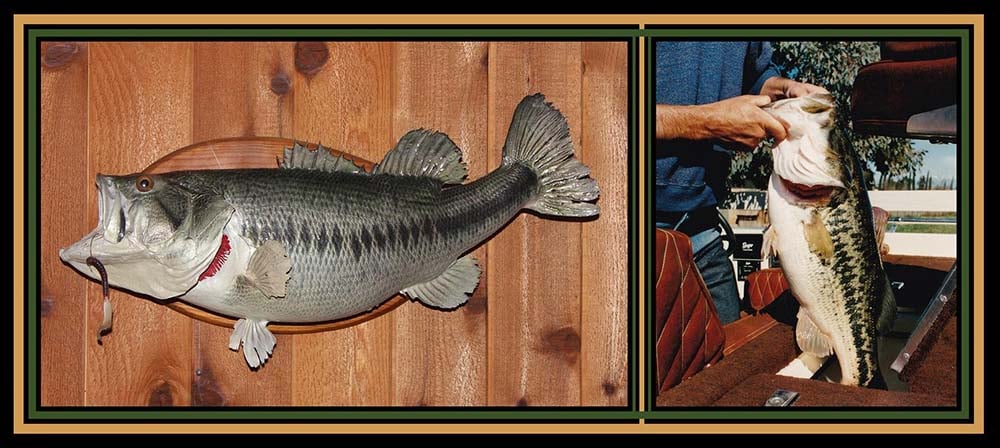
Many taxidermists specialize in a particular animal group, and some will limit their practice to certain animals or mount types. If your truck transmission needs rebuilding, you wouldn’t take it to an auto body repair shop, would you? I’ve seen walls full of beautiful fish mounts displayed by large taxidermy companies, but they don’t do fish taxidermy themselves… Fish, birds and reptiles are often contracted to outside specialists for mounting. You can avoid the “middleman” and extra cost by going to the source when possible. Again, it pays to ask who will actually be doing the work you have ordered.
Great Taxidermy
Over the years I’ve had many animals, birds and fish mounted by various taxidermists, with mixed results from both large companies and one-man operations. Although there are exceptions, particularly with trophies from international hunts, I have used small shops with a single taxidermist/artist for the majority of this work. Establishing a working relationship with a top-notch taxidermist that you know and trust can pay dividends, and I enjoy one such relationship with Kayce Turley, owner/operator of Arizona Game Services in Taylor, Arizona (928-587-3523). Kayce and I have become friends over the past 20+ years, occasionally sharing a duck or quail hunt. He is currently constructing an African habitat in which my full-body mount nyala bull (pictured above) will be displayed.
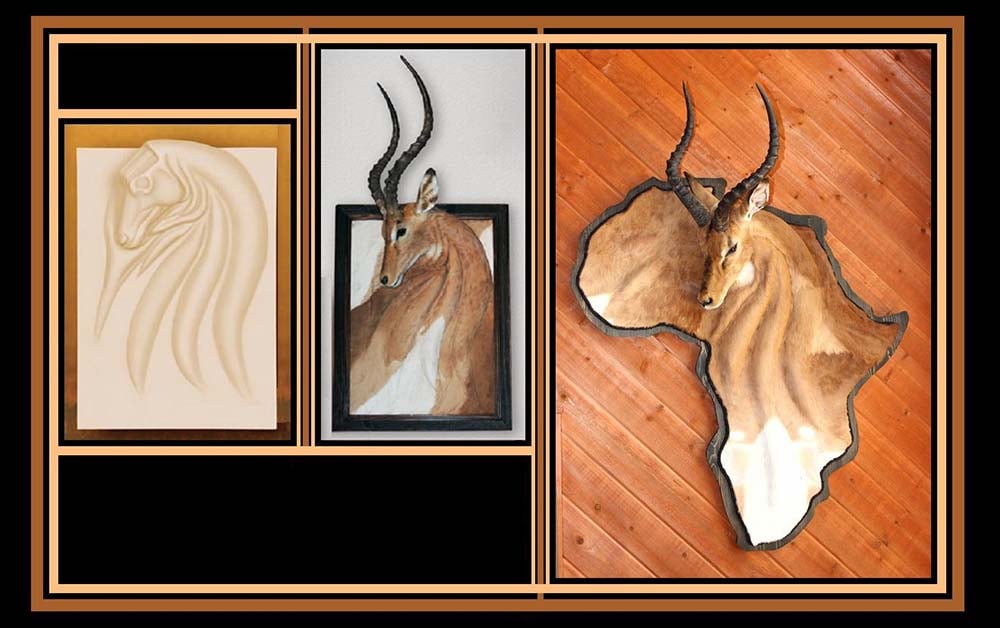
Personally, I like variety and often look for non-standard positions that will distinguish my mounted animals from others. A few years back at the SCI Hunters Convention, my wife and I were impressed by a custom taxidermy/wildlife art exhibit that featured wall mounts called “toiles.” Last year, standard rectangular-shaped toile forms for several African animals were licensed by originator Trophy Consultants International (TCI) to U.S. taxidermy supply company, McKenzie. After discussing the toile with Kayce, we decided to try the concept with one of the impalas I had taken in Africa, and he ordered the form. Last week he surprised me with the remarkable piece of custom wall art pictured above. Shaped like the continent, it surpasses my greatest expectations. As noted above, maintaining a relationship with a first-rate wildlife artist/preservationist can pay dividends – and after going above and beyond, this example is now manifested in truly great taxidermy!




Leave a Reply